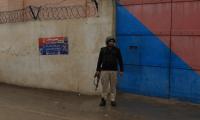ISLAMABAD: The National Accountability Bureau (NAB) has become a huge entity over the years. After the Election Commission of Pakistan (ECP), it has become the largest constitutional body with almost 1,900 employees.
NAB’s growth has been so phenomenal that it has left behind key constitutional bodies like the Senate Secretariat, the Supreme Court of Pakistan, the Presidency, and the Prime Minister’s office/house. NAB’s share in the total employees of all the constitutional bodies is now almost one-fourth.
Official figures for the year 2019-20 show that there are a total of 8,253 employees working in various constitutional bodies. The number and share of various bodies is as follows: the Election Commission of Pakistan (2,330) 28.23%, National Accountability Bureau (1,885) 22.84%, Senate Secretariat (1,027) 12.44%, Supreme Court of Pakistan (657) 7.96%, the Wafaqi Mohtasib (Ombudsman)’s Secretariat (536) 6.49%, the President’s Secretariat (personal) (479) 5.80%, the Prime Minister’s Office (public) (460) 5.57%, the Prime Minister’s Office (internal) (318) 3.85%, President’s Secretariat (public) (265) 3.2%, the Federal Tax Ombudsman Secretariat (193) 2.34% and Council of Islamic Ideology (103) 1.25%.
An analysis of employees in BS 1-16 working in constitutional bodies shows that BS-1 has a 16.96% share in the actual strength of 6,727, BS-16 has 13.02%, BS-9 has 9.94%, BS-4 has 9.78, BS-3 has 9.32%, BS-11 has 8.10%, BS-2 has 7.22%, BS-15 has 7.02% and BS-14 has 6.05% share while other scales have less than a 4% share.
The NAB’s sanctioned strength is 2,177 while the actual number of employees working in the organization is 1,885. Out of these officials, 493 are serving in grade 17 to 22 whereas the remaining 1,392 is working in BS-1 to BS 16. These figures show that the organization is a top-heavy body as the officer-staff ratio stands at 1:2.8.
An earlier official report —Annual Statistical Bulletin of Federal Government employees for the year 2017-18 — had compared NAB with federal ministries and divisions to show that NAB was the most bloated, top-heavy body in the main federal secretariat, even beating the all-important federal divisions like Foreign Affairs, Finance and Planning Development and Reforms.
It was said that there were a total of 21,144 employees working in the main federal secretariat. These employees included 4,034 in BS-17-22 and 17,110 in BS 1-16.
“For BS 17-22 out of actual working strength of 4,034 the major part (13.09%) is working in the National Accountability Bureau,” the report had revealed.
About the position of employees in the main Secretariat, the 2017-18 bulletin had said, “There are a total 21,144 employees working in the main secretariat, out of those 4,034 are in BS 17-22 and 17,110 in BS 1-16. For BS 17-22 out of an actual working strength of 4,034, the major part 13.09% is working in the National Accountability Bureau. The Foreign Affairs Division ranks second with 12.27% of the actual strength of BS 17-22. The Information & Broadcasting Division with 6.79%, Planning Development & Reform Division with 5.73% and Finance Division with a 5.28% share stand third, fourth and fifth respectively.”
Even in the category of low-level employees — BS 1-16 — NAB had the second largest number. As for the 17,110 federal government employees in BS 1-16 working in the secretariat, the bulletin showed which entities had the maximum employees: 10% are in the Foreign Affairs Division, followed by the National Accountability Bureau with 8.38%, Finance Division, National Assembly Secretariat and Senate Secretariat with a 5.60%, 4.77% and 4.55% share respectively.
NAB sources say that the Bureau has countrywide operation and have offices in all bid cities. Moreover, it has investigation and prosecution processes, so it requires more staff than many other state institutions.
NAB recovered more than Rs533 billion in previous years and this amount id far more than its expenditure.
Hospital Director Dr Khalid Masud said that hospital had reduced number of patient referrals to other hospitals by 90%
Maryam strongly condemned bomb blast in Turbat, and paid tribute to all those who lost their precious lives in explosion
First track spans 10.1 kilometres, stretching from Sea View to gate of Golf Club
According to local media, unidentified gunmen burst into bar La Casita Azul and opened fire at customers
Bureau of Meteorology official Miriam Bradbury said temperatures would likely peak in Victoria
Such tool allows budget-related bills to clear 100-member Senate with simple majority, rather than typical 60-vote...







